ACT
National Archives of Australia – Canberra
New building
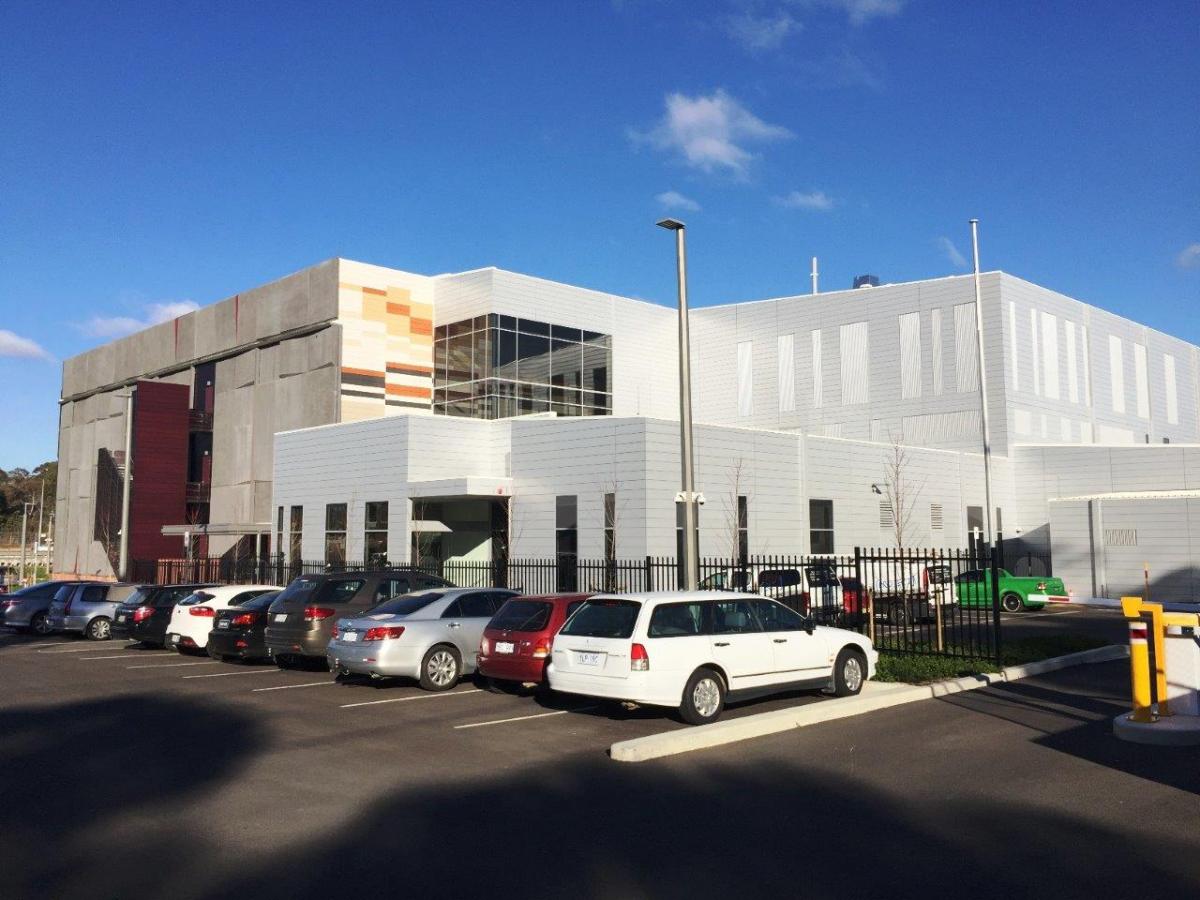

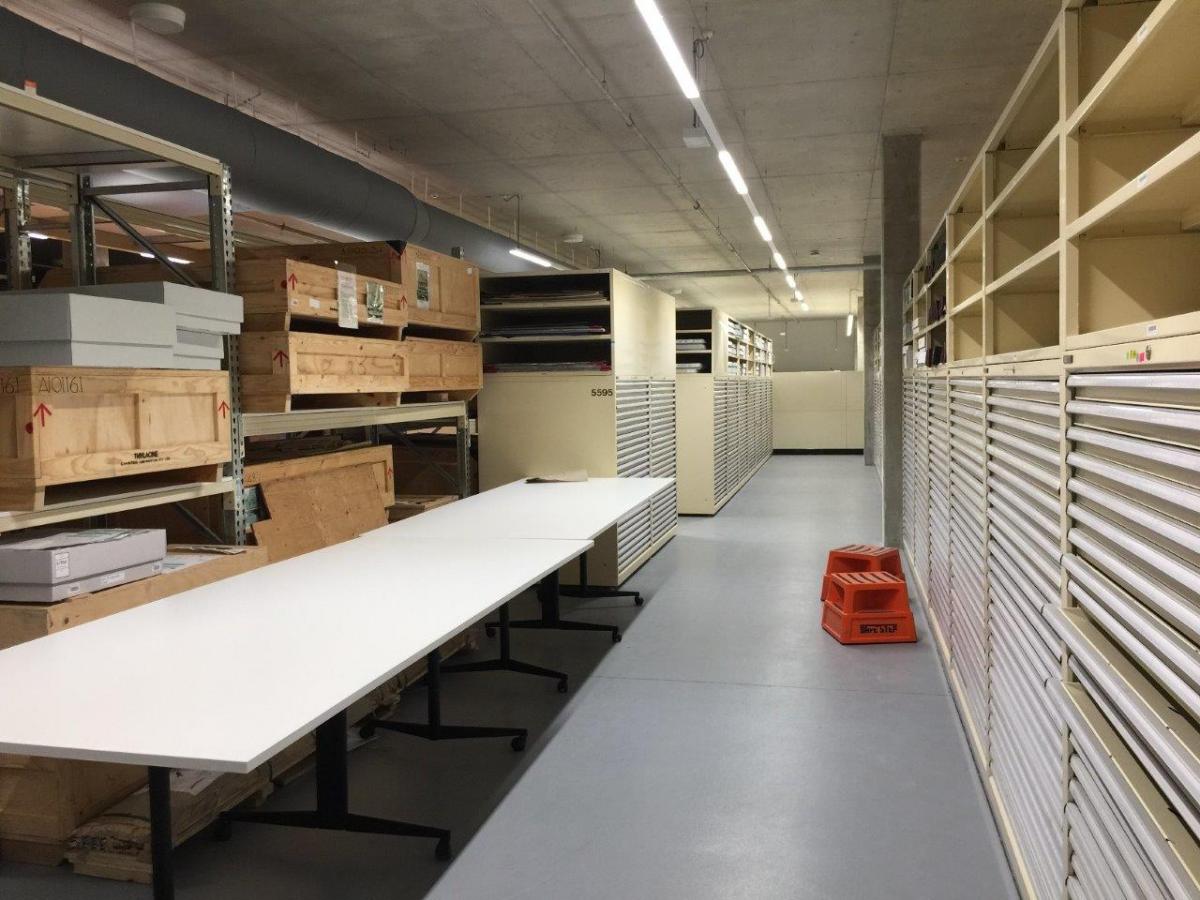
Preservation staff are settling in very nicely to their new conservation lab at the National Archives Preservation Facility (NAPF), the new Archives repository in Canberra. Particularly favoured are the custom-made tilting benches (with electronic controls) and the huge stainless steel sink. The new lab has more electrical outlets than we know what to do with, huge windows (which we also don’t know what to do with, as we had none at all in our old lab), special new facilities for analysis and testing of materials, and a large separate office for staff.
The NAPF has specialised storage for AV materials, with cool, cold and freezer rooms, as well as huge general storage areas over three floors. The official opening of the building will be on International Archives Day, 9 June.

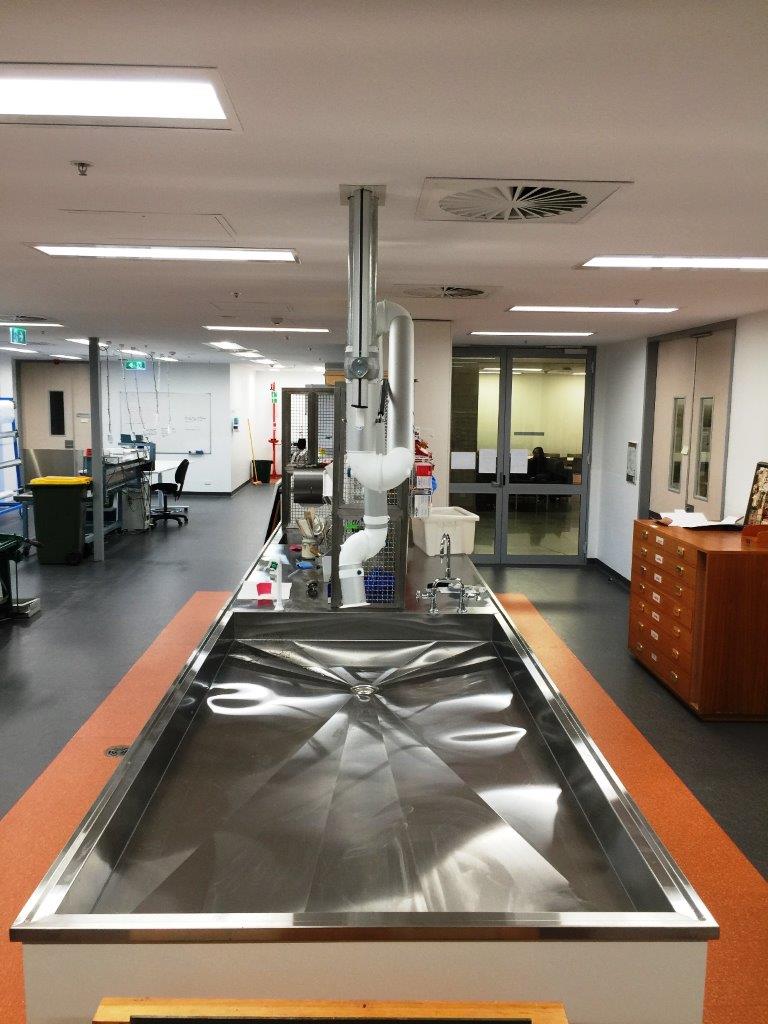
To welcome staff to the new building, introduce non-Preservation people to our lab, and mark May Day (an international day to highlight the need to save our archives) Clair Murray organised, and Preservation hosted, a very successful staff open day in the new Conservation Lab. Staff could come through for tours of the facilities and demonstrations of some of our equipment, and quite a few people brought along treasures for condition checking and advice about their care. We think the conservation clinic might become a regularly recurring feature here at the NAPF.
Exhibitions
Prue McKay, Suellen Bailey and Steve Willett installed and deinstalled, in the space of a week, a showcase of documents relating to the 55th anniversary of Australian/EU relations, to coincide with an even at the Department of Foreign Affairs and Trade (DFAT). The showcase was placed in the DFAT main foyer area.
Media
Travis Taylor and Sally Kneebone assisted with a visit by Stan Grant and the ABC, who were filming the Constitution Act and the 1967 Constitution Amendment Act. These documents are kept in our Federation Gallery and require special handling to remove them from their showcases.
Workshops and Conferences
Our jet-setting team is at it again, with several staff having been selected for overseas events in a few months’ time. Cheryl Jackson is first off the mark, going to Los Angeles for the Twentieth-Century Color Photographs: Contemporary Practice, Identification, and Preservation workshop at the Getty Villa, 7–11 August. Caroline Milne is away next, presenting a paper about the Archives’ recent relocation, at the 83rd IFLA General Conference and Assembly, 19–25 August 2017 in Wrocław, Poland. Then, before Caroline has even hit the ground back in Canberra, Prue jets off to Japan for the three-week ICCROM Japanese Paper Conservation course in Tokyo and Kyoto, 28 August–16 September.
National Museum of Australia
It has been a while since the last post from Conservation at the NMA, so here is a snap shot of some of the things that have been keeping us busy this year.
Exhibitions
Conservator Nathan Pharaoh and Registrar Mat Doney travelled to Thursday Island in late 2016 to assess and document the masks in an exhibition at the Gab Titui Cultural Centre. In March this year, Nathan returned to the Torres Strait with Mark Worrall to prepare the masks for travel for the exhibition Evolution: Torres Strait Masks. This exhibition celebrates the history, significance and continuing tradition of making and using masks in the Torres Strait. The complexity of these contemporary masks required ingenuity in packing design to ensure the safety of the objects during transportation by barge and then road freight to Canberra.
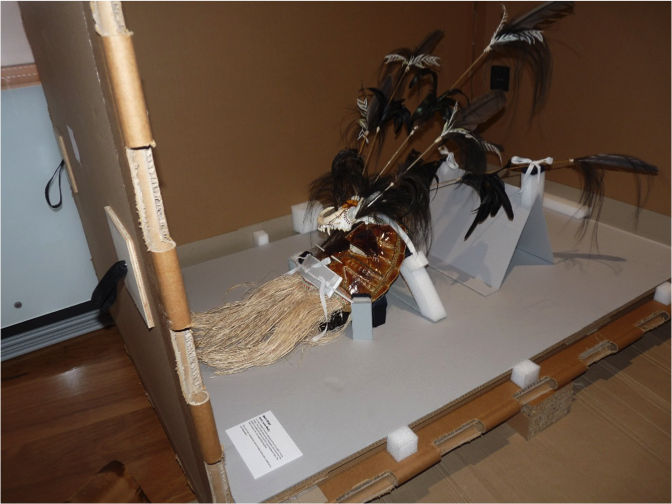
Nicki Smith has been leading the team preparing for A Change Is Gonna Come, an exhibition commemorating milestones in Indigenous activism, including the 50th anniversary of the 1967 referendum and the 25th anniversary of the 1992 Mabo decision. This exhibition, curated by Brenda Croft, features historic and contemporary objects and works of art that invite the audience to reflect on the changes that have occurred and whether more change is still to come. The exhibition runs from May 2017 and January 2018
The exhibition One Road – Aboriginal Art of Australia’s Desert, exploring the famous Western Australian droving road (the Canning Stock Route) travelled to venues across Japan over the course of late 2016 to early 2017. NMA Conservators including Nicki, Prue Castles and Natalie Ison, and Registration staff, travelled to each venue, commencing in Chiba (just outside Tokyo) to install and de-install the 34 paintings in conjunction with local staff.
It was a great opportunity to work with colleagues in Japan and experience Japanese culture, tradition and food. Staff were all extremely professional, competent and respectful. Highlights included having to take off our footwear and put on steel-capped crocs to enter collection storerooms.
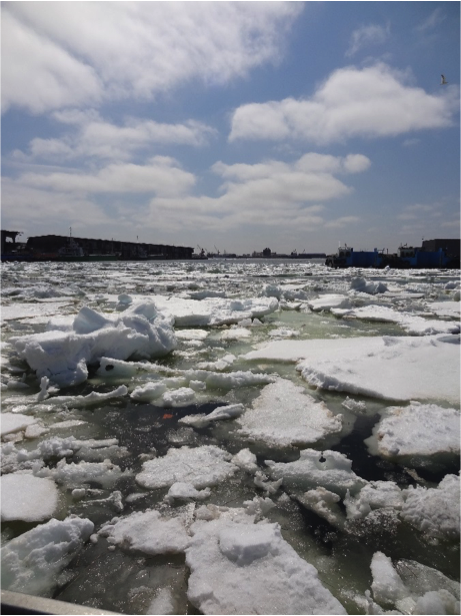

March 2017 saw the removal of the display of large technology objects out of the Museum’s Main Hall in preparation for the renovation and rejuvenation of that space. With the launch due later this year, Tania Riviere, Nicki and Donna Wilks have been investigating how to manage environmental conditions in the Hall’s large structural columns that will house the new display cases. This has included looking into an active humidity control system within the individual cases and a Wi-Fi data logging system that will read into the column/display space structures. The aim of the column showcases is to provide a streamlined exhibition space and to enable object material types, not previously suitable for display in this space due to light and environmental conditions, to be displayed safely.
Workshops and Conferences
Jen Brian recently attended the AICCM Shock of the New: Modern Materials, Media and Methods symposium in Melbourne and presented her experiences to the rest of Conservation. This brought up some fantastic discussions surrounding the conservation, acquisition and documentation of time based and digital works, 3D printing technologies, and modern materials and media in conservation – a subject that is becoming more relevant across most collecting institutions.
Media and Events
“The Harvest of Endurance” is a painted Chinese scroll in the National Museum’s collection that is over 50 metres in length, and highlights survival and resourcefulness across two centuries of Chinese settlement in Australia. As part of the Canberra International Music Festival, narrator William Yang, Ensemble Offspring, the Song Company and Luminescence Chamber Singers performed alongside the scroll at the Museum on Thursday 4 May. Conservators Jess Wignell and Nick Zihrul were involved in preparations for the event, and Jess attended to facilitate audience viewing and to answer questions about the scroll. There was a large digital display of the whole scroll, but people were keen to see the five metres (two panels) of the real thing that were available for inspection.
Jen worked recently to facilitate the playing of an historic violin in the NMA collection by the great-great grandson of its maker. This has stimulated a research project into the place of musical instruments in the NMA collection as functional and/or time based objects and the opportunities that this may pose in preserving the physical and ephemeral qualities of this collection. To hear the playing of the violin, go to: http://www.nma.gov.au/about_us/news/articles/great-great-grandson-plays-…
Cruising
The National Museum of Australia has been providing ‘cultural tours’ on the Princess Cruise Line. These tours include graphic panel displays dealing with the Museum’s Defining Moments project installed on five Princess Cruise Liners, curator and conservator talks on board the Emerald Princess and a display of objects – the museum in a suitcase – for discussion with passengers on the Emerald Princess. In March this year, Natalie Ison presented “A place of stories and things: Conservation at the National Museum of Australia” during a cruise from Auckland to Sydney. In April, Vicki Humphrey presented two lectures: “Conserving the Royal Daimler” and “Defining Moments in Australian History” cruising from Port Chalmers in NZ to Sydney. This added an interesting new dimension to our work, including for Natalie large sea swells leaving her airborne at various stages during the night.
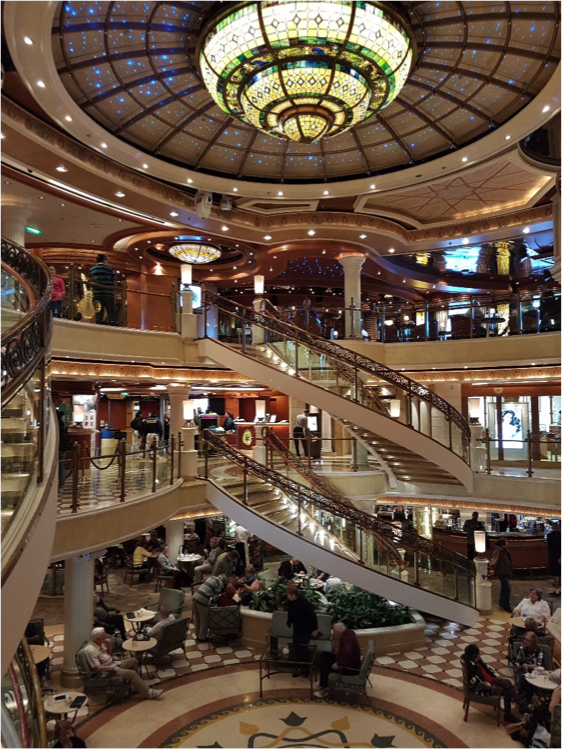
NSW
Australian National Maritime Museum
Treatment Projects
Sue Frost with the assistance of Jeff Fox and Luci Ronai have preparedan impressive selection of the Museum’s swimsuits for photography for the Google Cultural Institute. This has generally involved dressing off-the-shelf mannequins in these costumes. However, some of the swimsuits are too tiny or too fragile and have required a custom-made body form. Photos are being taken to suit the high resolution standards required by Google (4000 pixels on smallest edge of the image). Images of our swimsuits will be part of the Google Cultural Institute fashion launch later this year.
There was an opportunity for Museum visitors to see “conservation in action” as Jeff, Rebecca Dallwitz and Nick Flood undertook maintenance of the Seafarers Memorial Anchors at the entrance of the Museum. Ongoing maintenance involves removal corrosion products using specialised tools and spot application of a primer and topcoat to protect the iron objects from Darling Harbour’s marine environment.
The conservation of the Cape Bowling Green Lighthouse is a major ongoing project for the Museum. In order to document the considerable external and internal surface area of the Lighthouse prior to invasive works, photography from a drone and 3D modelling camera was recently undertaken. Rebecca commissioned contractors to produce a 3D model, virtual tour and source images of the lighthouse. Archiving of the source images will allow us to review 2017 object condition at any time in the future and recreate 3D models and tours as required. Jeff has been cleaning copper alloy air vents taken from the Lighthouse’s lantern room. He’s been using brass wool to mechanically remove unsightly corrosion products whilst leaving the protective rich brown patina intact. Nick has reinstalled the Lighthouse fuel system after an extensive treatment. This involved removing over 50 litres of kerosene from the fuel tanks. Corrosion and flaking paint were treated. Replacement copper tubing was fabricated to match technical drawings found in a catalogue from the manufacturer from the early 1900s.
Jochen Letsch (ASA Conservation Framing) has been invaluable in providing mounting solutions for the Museum’s recent acquisition of a number of Harold Cazneaux’s photographs.
Research Projects
Agata Rostek-Robak and Luci have completed a pilot condition survey of the cellulose nitrate and cellulose acetate negative collection material held by the ANMM and presented their findings to the Museum’s Collections Priority Group. This represents the start of a decision-making process on preservation management strategies to look after these materials. Agata and Luci hope to be sending out a nation-wide survey to find out about recent institutional responses to these hazardous materials.
Currently over 23,000 objects have been inspected as part of the National Maritime Collection Survey project. The survey will inform the Museum’s conservation strategies over coming years.
Exhibition preparation
Agata and Rebecca are preparing works for Saltwater – Gapu-Monuk: Journey to Sea Country a major exhibition of Australian Indigenous cultural materials due to launch in November this year. This will involve community consultation and a complete revision of bark hanging systems.
Several temporary exhibitions have been installed in the last few months including Lustre – Pearling & Australia andthe popular Escape from Pompeii. Readers should look out for the upcoming exhibitions:
- Wildlife Photographer of The Year
- Out of Hawaii (celebrating the pioneers of early surf culture and the achievements of Bernard “Midget” Farrelly)
- Aurora (commemorating 100 years since the disappearance of famed Antarctic vessel SY Aurora)
Workshops, symposia and media
Marking the arrival of the Hartog plate to ANMM in May, Tamar Davidowitz (Metals Conservator, Rijksmuseum) gave a fascinating presentation about her treatment of the object and its preparation for travel. The evening was a huge success attracting 70 dignitaries, members and guests, including approximately 20 AICCM members.

Jeff, Luci & Nick were involved in running a series of Senior Archaeology Workshops for high school students, where they were encouraged to investigate archaeological artefacts from the Dunbar wreck. Students really got involved and had a lot of fun.
Ledby Luci, Conservation took over the Museum’sInstagram account for a day. Five stories were prepared including a video lab tour, the treatment of the Cape Bowling Green Lighthouse, maritime archaeology conservation and swimsuit photography for the Google Cultural Institute. The #ANMMconservation posts received an above average response from followers.
Social news
The 20th Annual Staff Regatta was held on a beautiful sunny, but windless, afternoon in May. Five yachts completed with crews assigned according to their area in the Museum. The Conservation and Fleet sections teamed up to crew the 36-foot yacht Iyeia. The race around Sydney Harbour began at Garden Island, passed Clark Island and finished at Shark Island. A fantastic time was had by everyone on board with no sea sickness to report. At the end of the day Iyeia finished last (but not least).
Preservation Australia and Conservation Resources
Training
Kay Söderlund delivered two separate disaster training sessions for the Queensland Archives in Brisbane in May. One day was for the Record Managers and focused on Disaster Preparedness plans with some recovery and salvage. Day two was open to the public and included a remote participant via “Beam Pro”.
Tegan provided Hazardous Materials in Museum Collections training to Albury City Museum staff and other local museum professionals from the area. This training provided staff with the essential information in identifying the potential hazardous materials in their collections. The workshop raised many interesting questions regarding the content of collections and the best approach in managing the hazards. Tegan has also provided other training sessions to NIDA on handling of photographic and paper materials and a disaster preparedness session to the Greater Hume district.
Assessment
Tegan Anthes has been working closely with a variety of clients oncompleting Preservation Needs Assessments of their collections for the Community Heritage Grant program. Tegan has travelled to Woodford, Albury and locally to Newtown to complete these assessments.
Treatment Projects
Beate Yule has been working on a series of certificates with iron gall ink. This follows on nicely from the Iron Gall Ink workshop she attended last year as part of the AICCM Book and Paper Symposium. Beate has been able to use the skills learnt in the workshop with the certificates with great success.
Workshops and Conferences
Kay is attending the AIC conference in Chicago later this month, the theme is Treatment 2017: Innovation in Conservation and Collection Care. Kay is lucky enough to be able to meet up with Robin Hodgson and together they are going on a road trip from Palm Springs to Chicago.
Tegan is attending the Getty Intensive program “Managing Collection Environments: Preserving Collections in the Age of Sustainability” in Philadelphia in June. This program includes an online module, a two-week intensive and a six month mentoring program.
Social News
Preservation Australia celebrated Women’s Day by going out for lunch. We are a business that is owned and managed by women and we were happy to celebrate this day. We welcome all other women in business to join us next year!
Art Gallery of NSW
Treatment projects
In paintings conservation, Celine de Courlon is undertaking a major conservation project of Julian Ashton’s painting, The Prospector, thanks to generous support from the Pohl Foundation. A new reproduction frame is being made by David Butler and Tom Langlands.
Thanks to the generous donation of several conservation benefactors, Arthur Streeton’s painting Villers Bretonneux has been restored by Celine. The treatment of the frame will start in June and will be undertaken by frames conservators Emma Rouse and Malgorzata Sawicki. The painting will be displayed in December 2017 in the NGA’s exhibition Arthur Streeton: The art of war.
Exhibitions and loans
Objects conservation have been working feverishly to prepare a large number of works for the upcoming collection changeover in our Asian galleries. Kerry Head has mounted several of the Gallery’s beautiful kimonos for display, as well as some other splendid textiles, while Kasi Albert and Melanie Barrett have been condition checking and undertaking minor treatments on a huge array of ceramics and lacquer items. Kasi and Kerry also recently prepared a sculpture by important British artist William Tucker which has been in the collection for some time, but has never been on display.
Analiese Treacy has been completing work on a collection of over 90 watercolours from the Victorian Era which are due to go on display in June 2017. Many of these works were amongst the first items acquired by the AGNSW and some have never been displayed before. Reproduction frames makers Tom and David have been busy finishing off reproduction frames and gilded slips for the watercolours, with Tom also creating several French mats.
The frames conservation team, Margaret Sawicki, Basia Dabrowa and Emma Rouse, are also in the final stages of conserving works for the Victorian Watercolours exhibition that will run from 2 June to 16 December 2017. Over 70 original elaborate gilded frames were treated. Some examples of the treatments undertaken include the removal of bronze/brass-based overpaint, laser cleaning, replacement of losses in sections of ornament and in-gilding.
Basia also conserved a couple of frames for the David Stephenson Human landscape photography exhibition, which was opened on 15 April 2017 and runs until 23 July 2017. Paper conservator Sarah Bunn couriered the Dobell Biennial exhibition 2016: Close to Home to the Western Plains Cultural centre and participated in a public talk with artist Catherine O’Donnell.
Research projects
Paula Dredge, Simon Ives and Malgorzata Sawicki recently went to the Australian Synchrotron in Melbourne to identify paint media on several collection artworks.
Paula also worked with the Heide Museum of Modern Art and the Australian Synchrotron on a Nolan conservation imaging project. She collaborated with Andrew Yip from the Laboratory for Innovation in Galleries, Libraries, Archives and Museums (iGLAM) and Matt Nix from the AGNSW on a VR installation that shows what could be a self-portrait hidden underneath Kelly’s mask on Nobody knows anything about my case but myself from the Heide Museum of Modern Art.
The AGNSW conservation team is also pleased to be partnered with the University of Melbourne and other organisations on a project addressing the conservation of plastics in cultural collections, supported by the Australian Research Council. The Gallery is embracing the opportunity to identify plastics within the collection and hopefully start a regular program of analysis and documentation.
Workshops and conferences
Head of conservation Carolyn Murphy, time-based art conservator Asti Sherring and objects conservator Kasi Albert all presented at the recent Shock of the New Objects and Electron SIG symposium in Melbourne. It was a fantastic event and presentations about the way that the AGNSW is managing contemporary time-based and installation artworks were very well received.
Asti, along with Lisa Catt, assistant curator of international art, secured a joint invitation to attend a fully funded workshop at the Museum of Modern Art, New York on behalf of AGNSW. In May, they travelled together to New York for one week to attend the Time-based art workshop and meet with colleagues at major institutions around the world who are also involved in time-based art management, as well as dealer galleries in regards to specific collection works and proposed acquisitions. Asti stayed on for a second week to meet with conservators at other major art museums in New York City, including the Whitney Museum of American Art, Solomon Guggenheim Museum, the Metropolitan Museum of Art, and New York University. Asti’s additional travel has been generously funded by the ISSI Institute. Successful entry into this workshop was highly sought after, which shows the international need to address this area of research and the reputation of AGNSW as emerging leaders in this field.
Social
There have been numerous comings and goings over the past few months in conservation.
Exhibitions conservator Frances Cumming is on leave for three months for a well-deserved break. Objects conservation is happy to welcome back Melanie Barrett, who has returned part-time after her maternity leave. Lucy Tedder worked one day a week for a few weeks in the painting lab restoring Joseph Backler’s Portrait of John Thomas Wills. Celia Cramer is currently undertaking a 5-week professional placement in the painting lab and a 2-week professional placement in the frame lab.
Paula is undertaking a two-month residency at The Rodd, Sidney Nolan’s home in Wales. She is cataloguing, photographing and sampling the materials left in the artist’s studio, in particular his use of spray paint in cans, to build further understanding of his materials and practice. She gave a floor talk at the exhibition Unseen: Works from the Sidney Nolan Trust Collection at Australia House in London. She also gave a talk at the Sidney Nolan RA centenary symposium at the Royal Academy in London. Her residency is supported by the Art Gallery of NSW, Rowena Danziger AM and Ken Coles AM, The Gordon Darling Foundation and the Sidney Nolan Trust (UK).
Sydney University Museums
Exhibitions
It’s full steam ahead preparing new content for the Chau Chak Wing Museum due to open in late 2018. With a new museum to fill with exhibitions on a wide variety of themes, we are assessing and treating many objects that have previously not been displayed. As a result, we have more people contributing to the process and also bringing their own skills and experiences.
Dee McKillop, Wendy Reade and Alayne Alvis are based in the Conservation Lab, with Dee working on paper-based media, and Alayne and Wendy working on a variety of objects.
Laura Curtis and Céline de Courlon have spent sessions with us working on objects and paintings, respectively.
With more people in the Lab, we have also had more volunteers with us: Eleanor Curtis working with Wendy and Nastaran Fourezeh working with Alayne.
While times are very busy for us, there’s been a benefit having so many conservators working together and sharing knowledge. One benefit is planning the Conservation Lab in the new building, so we are all doing a bit of “blue sky thinking” to get the best result we can.
We are also looking at becoming a “node” for a very large across-campus analysis and research group, with the Conservation Lab being the specialist area for portable non-destructive analysis.
Heights Heritage Conservation
Treatment Projects
The beginning of this year has been a time for BIG THINGS with the conservation and framing of two large silk artworks to hang in the Lend Lease offices at Barangaroo and the cleaning of two very large tapestries: The Mona Hessing ‘Banner’ tapestry which hangs in the Clancy Auditorium at UNSW, measuring 2.5m high by 24m long; and the ‘Terra Australis’ Tapestry by Alun Leach-Jones, 5m x 7m which was woven by Victorian Tapestry Workshop in 1992 and acquired by the Sydney International Airport, but has been in storage since 2012. It will soon take pride of place back in the International Terminal having been wet cleaned and a new hanging system added. The last in the list of large projects is the cleaning and modifications to the 14m long Woolloomooloo Artwork Curtain by Lucust Jones, located at the Juanita Nielsen Community Centre, Woolloomooloo, Sydney.
There has also been a steady stream of war memorabilia including a collection of uniforms for the Sydney Jewish Museum, a WW2 leather pilot’s jacket from a private collection, an 1860 Cross Belt Pouch for the Anzac Memorial and a very special collection of 1800s medals from campaigns in Afghanistan, India, Kabul and Abyssinia together with a Commander of the Most Honorable Order of the Bath.
Exhibitions
Tess Evans has also prepared and mounted three permanent exhibitions. The Sydney Jewish Museum Redevelopment is now finished with the Holocaust exhibition officially opening in March.
A small exhibition En Route to Exmouth telling that town’s short history as an American naval base, whaling port and centre of communications has been mounted within the Ningaloo Visitors Centre and will be officially opening to celebrate Exmouth’s 60th birthday.
And lastly Tess cleaned, repaired and mounted archaeological artefacts found at the site of Day Street, Darling Harbour, Sydney during excavations. The artefacts represent different phases of European occupation of the site from its early use as a flour mill, tweed factory and later as warehouses.
TSIG
Tess has recently set up a Facebook Group named ‘AICCM Textile Special Interest Group’, so that group members can share special projects, information, new products and anything else that fits the TSIG bill, but also to be a platform to help plan the next Textile Symposium in 2018, so if anyone has any burning desire for a particular topic, workshop, or guest speaker, please post it here and let’s get the ball rolling.
Social News
In January Tess completed her training with Cantoo competing in the 2km Bondi Classic Ocean Swim and made her fundraising pledge by raising over $2,000 for Cancer Research. Thank you to all those who sponsored her.
In March Tess returned to India with her husband and the Different Travel Group to revisit the I-India Project of two years ago where they built a playground, this time working on ‘beautifying’ the Child Inn; a boys refuge in Jaipur. The world map designed by Tess was much appreciated by the boys, some as young as five, rescued from bonded labour.
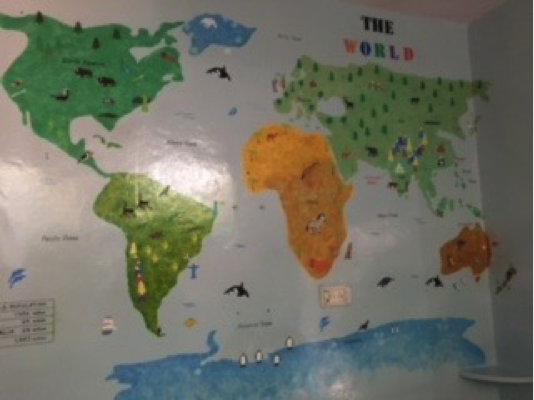
International Conservation Services
Treatment projects
Our Objects and Heritage Team have been very busy lately. New members Amy Jackson and Frances Paterson recently worked with Karina Acton and Annick Vuissoz to undertake maintenance works on a bronze sculpture at the Reserve Bank of Australia.
Katy Ross has undertaken several condition surveys and scoping jobs ahead of the DVA grant submissions for war memorials. Preliminary conservation works have also started on two Howitzers from the Rocky Hill Memorial in Goulburn and a scoping study for the conservation of a grotto in Rhodes.
Arek Werstak is currently working on a paint investigation of the Old Treasury Building lamp posts in Melbourne and recently carried out conservation of the Town Hall station heritage tiles.
And James Kleppen has been working on a number of large war memorial projects, as well as the conservation of a 1904 Krupp field gun.
Skye Firth and Gail Hamilton in our Textiles Team have been finalising treatment the Birdwood flag and working on a fragment of ribbon from the official opening of the Harbour Bridge. They’ve also been working on a collection of school caps from the de Pury family collection belonging to the Yarra Ranges Museum in Lilydale, Victoria.
Meanwhile, Eliza Penrose, Wendi Powell and Katie Wood in our Paper Team have been carrying out repairs to part of a collection of damaged colonial registers. They’ve also been condition reporting and conserving a large collection of Architectural drawings on linen and tracing paper.
Oliver Hull and Rob Williams recently completed reinstalling a collection of heritage cellar floorboards from 1801 in Sydney’s, Parramatta. Oliver has also been working on a large number of antique furniture pieces including a sideboard and dining table.
Matteo Volonté, Claire Heasman and Jennifer O’Connell in our Paintings Team have been working on various paintings including a piece by Pro Hart for Muswellbrook Regional Art Centre and a piece by William Piguenit. Matteo is also working on a lovely portrait by Tom Roberts.
Fiona Tennant has been working on several Preservation Needs Assessments, including one for Old Dubbo Gaol’s collection (with Oliver Hull), and another for the National Trust’s S.H. Ervin Gallery (with Claire Heasman).
Workshops and Conferencess
Back in April, Wendi Powell had a great time at two courses: ‘Byzantine Binding’ at Andersen’s Bindery and ‘All-in-One Box’ at the NSW Guild of Craft Bookbinders. The courses were taught by Michael Burke and Dominic Riley who were over from the UK.
Social
We are delighted to welcome Amy Jackson and Frances Paterson to our Objects and Heritage Team – Amy in the role of Conservation Projects Assistant and Francesas Conservation Projects Coordinator.
Victoria
Grimwade Centre for Cultural Materials Conservation
International visitors
In April three conservation researchers – Liang Jiafang, Wang Xiaoxiao and Yan Jing – from the Shaanxi Provincial Institute of Archaeology in Xi’an, China were hosted by the Grimwade Centre.
The team (including Dr Nicole Tse and Honorary Professor Tonia Eckfeld) spent a week at the Australian Synchrotron, continuing research commenced in 2015 on the analysis of Tang and Sui era tomb wall paintings, and is now analysing the resultant data.
During their stay in Melbourne, each researcher gave a presentation at the Grimwade Centre to students, staff and interested members of the public about their important conservation work in Shaanxi province. One highlight of these presentations was learning about Wang Xiaoxiao’s work on the integral moving of a Jin dynasty (1115–1234) brick tomb with mural paintings discovered in Ganquan County, Shaanxi Province during road construction.
Forum
With the support of the Australian Government through the Australia–ASEAN Council of the Department of Foreign Affairs and Trade, the Grimwade Centre co-hosted a forum on ‘Natural disasters & cultural heritage in the Philippines: recovery & reconstruction’ together with the National Museum of the Philippines and Southeast Asian Ministers of Education Organization Regional Centre for Archaeology and Fine Arts (SEAMEO-SPAFA) from 4–5 April 2017. A detailed review of this forum is in this newsletter.
Research Projects
Julianne Bell has joined the Grimwade Centre-led ARC Linkage Project “A National Framework for Managing Malignant Plastics in Museum Collections” as the recipient of a prestigious APAI PhD scholarship. Julianne’s thesis project is titled Developing a Nationwide Strategy for Managing Three-Dimensional Cellulose Ester Objects in Museum Collections.
Museum Victoria
Treatment projects
As part of the ongoing restoration of the Beizam Hammerhead Shark Mask (previously on display outside the café at Melbourne Museum), Karen Fisher travelled to Cairns with curator Lindy Allen to work directly with artist Ken Thaiday Senior on the final aspects of the artwork. This included sourcing materials, arranging transport logistics, and learning/documenting featherwork. With Ken’s permission Karen will complete the remaining tasks before the Mask enters the collection.
Lizzie McCartney has been assisting members of the Astronomical Society of Victoria to test the refractive index of the lenses from a number of eyepieces from the Great Melbourne Telescope. This information will be used when commissioning new eyepieces for the restored telescope.
Survey and guidelines projects
Danielle Measday has finished a survey of specimens in anoxic storage in the mineralogy and paleo collections with the kind loan of an Oxybaby from the Australian War Memorial. The results were very interesting and will help inform future practices around long term anoxic storage in these collections. Danielle and Rosemary Goodall have started a survey of the dry invertebrate slide collection, hoping to identify adhesives, sealants and mounting fluids used (and yes, this does include sparkly nail polish). Danielle and Rosemary have also begun a survey across the Sciences and Humanities collections testing the presence of mercury vapours inside storage cabinets where objects containing mercury have previously been identified. Belinda Gourley has recently finished writing guidelines for the housing and storage of paper, images and AV materials, and the digitisation of AV materials at MV. These are two massive pieces of work and Belinda has done a great job pulling all this information together.
Exhibitions and Loans
Karen, Sarah Babister, Charlotte Walker and Lizzie have been busy on loans and exhibitions including the loan of a number of agricultural models for the 50th Anniversary Celebrations of the Wheatlands Agricultural Museum, installation of a number of paintings from Ben Quilty’s After Afghanistan series at Melbourne Museum, installation of a display for the anniversary of the 9 May 1901 Opening of Parliament at the Royal Exhibition Building, and installation of the exhibition ‘Ganbu Yalingbu. Ngulu Bulok’ in Bunjilaka marking the 50th Anniversary of the 1967 Referendum. Sarah Babister has also been working on a number of new acquisitions that have been flagged for display at Immigration Museum in July to coincide with the AFL’s multicultural round. This material includes a collection of material from Lin Jong. Sarah resisted the urge to try on his VFL Premiership medal.
Congratulations!
Congratulations to Helen Privett and Rosemary Goodall for all their work in helping to develop the Museums Victoria’s e-learning module “Managing Hazardous Substances in Collections”. This module recently won the Learnx Platinum Award for Workplace Health and Safety.
Social News
We have been very fortunate to have interns Robyn McPherson and Tim Linden from the GCCMC with us for the past few weeks. Robyn and Tim have done excellent work on a variety of projects and it has been an absolute pleasure having them in the department. We would also like to welcome Emily Vearing, a student at GCCMC, to the Exhibition Collection Management department at Museums Victoria where she has taken up a position as a showcase cleaner, working across all three campuses to help keep our displays looking good. We have also bid a temporary farewell to Helen Privett who has taken up a year-long position as Museums Victoria’s Travelling Exhibition Project Manager. As predicted, she is taking to the new job like the proverbial duck to water.
State Library of Victoria
Events
In March, the book conservation team had a visit from David Lanning from Hewitt & Sons, a UK leather manufacturer. Discussion revolved around leather types and quality in relation to ageing properties, as well as types and use of leather dyes. David was also able to assist the book conservation team to identify a number of historic Hewitt’s leathers in our materials store.
In April, Conservation opened its doors to a small group of AICCM members to tour our purpose-built lab space. Guided by Conservation Coordinator Jane Hinwood, participants learnt about its interesting history (which originally housed the National Gallery School of Art), the daily workings of the Conservation, and had the opportunity to meet with their conservation colleagues at the State Library Victoria.
Conservation hosted students from the Conservation Masters at the University of Melbourne over two sessions. In the first, Senior Paper Conservator Marika Kocsis offered second year paper students an introduction to Japanese materials and techniques, with a particular focus on care and use of Japanese brushes, paste bowls and sieves, including a brief introduction to Japanese papers. The Book Conservation team later hosted the students for one full day, offering a practical session in book cradle construction, and a more theoretical session discussing different book structures for the purposes of condition reporting.
In other news, Albertine Hamilton (Conservation) and Leah Williams (Preservation) have been very active on social media recently, posting regularly to Instagram each Friday for the past three months. To get a look at what we’re up to behind-the-scenes at the Library, follow our hashtag #presconslibraryvic on the @library_vic Instagram account.
Treatment projects
In Conservation, treatment priorities continue to focus on preparation for exhibitions, loans and digitisation programs. The top priority in paper conservation has been in the treatment of architectural drawings prior to digitisation from the Alistair Knox and University of Melbourne architectural collections. These collections encompass a range of materials, including drawings on transparent paper, drafting cloth, various reprographic techniques, and watercolour drawings on paper. Another digitisation highlight includes the treatment of a 19th century sketchbook used by artist Richard Shepherd (H2006.135/1-252), which requires removal and repair of over 200 original artworks and prints, so that images on both recto and verso of each item may be photographed. A number of methods are being explored for releasing the adhesive used, including gellan gum.
Preservation activities are still centred on collection moves and rehousing prior to the Library’s redevelopment, which commences in a few months’ time. The Preservation team has been working hard in preparing material – mainly manuscript collections – for relocation. It seems never-ending, but the satisfaction of improving access is making up for it. Since May last year, Preservation have created approximately 650 new enclosures (albums, boxes, both custom and standard) for collection material, ensuring it is sorted, listed and discoverable. This equates to nearly 40 different collections, which were virtually inaccessible. Preservation have also relocated 120 collections from the Manuscripts, which will soon be redeveloped into a new exhibition gallery. This process has given us the opportunity to identify large and significant collections for future preservation work.
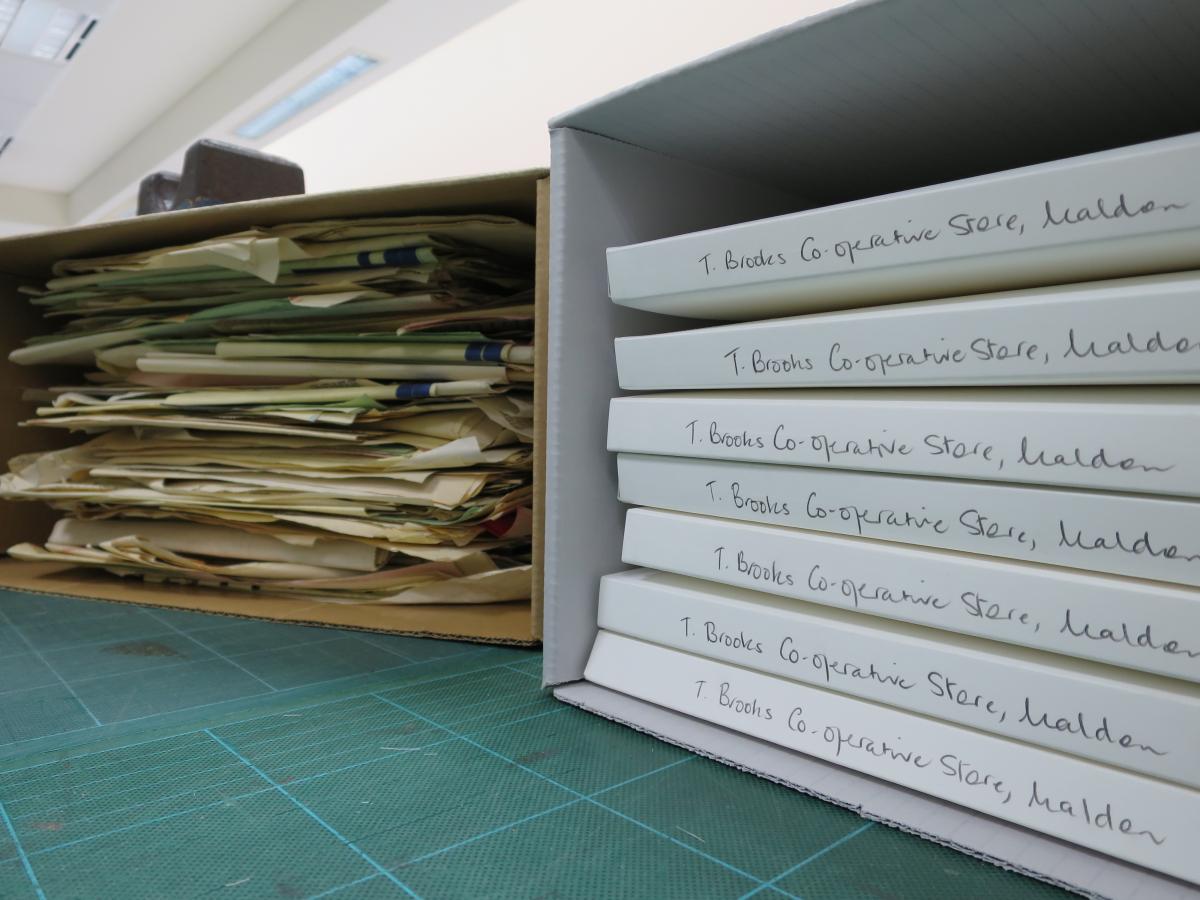
Digitisation treatment has focussed on ‘The Ballarat Evening Echo’ newspaper, 1915-1918. This has been a challenging task, with paper stock of particularly poor quality being very fragile and brittle. Heat set tissue has been sparingly used to stabilise creases and tears, to enable safe page turning during image capture. Another interesting collection that has required assessment for digitisation has been the very popular Sands and McDougall Directories, which list businesses and proprietors in Melbourne since the 1860s. The volumes are assessed for tears and repairs were carried out.
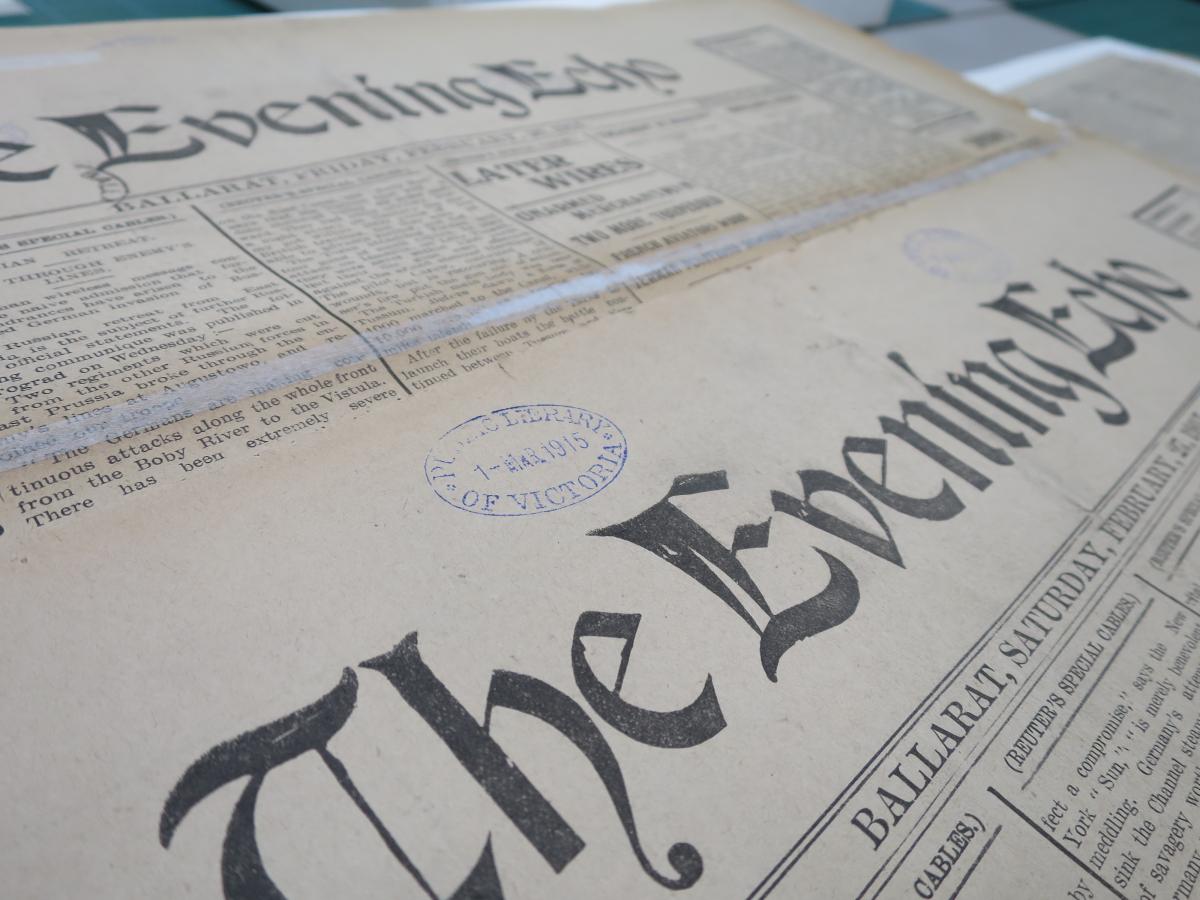
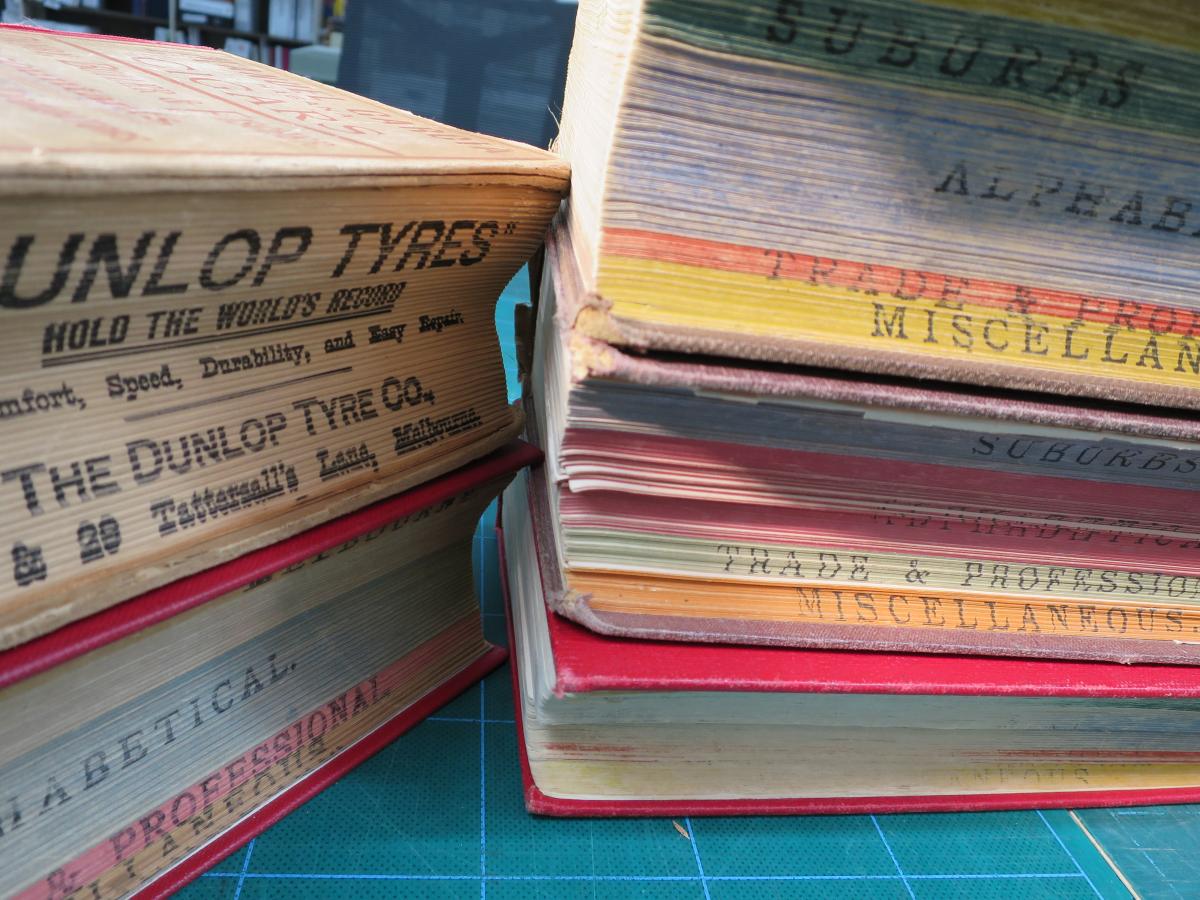
Exhibitions
Conservation staff are currently preparing material for the May changeover of our permanent Dome Gallery exhibition Changing Face of Victoria. New items in the exhibition include: a box containing 12 tubes of powdered synthetic mercury compound for the treatment of syphilis during WWI (H92.370/251); a tortoiseshell snuff box owned by early settler Dr Michael Minter (H2007.104/4); and numerous dramatic photographs of Melbourne buildings crumbling before ‘Whelan the Wrecker’ (MS 13237).
There have also been preparations underway for the Clunes Booktown Festival, which will take place on the weekend of 6-7 May. Library staff are taking a number of rare books, including Samuel Johnson’s Dictionary of the English Language of 1755 (RARESEF 423 J63) and Joannes Jonstonus’ Historiae Naturalis of 1657 (RARESEF 599 J64 V.1).
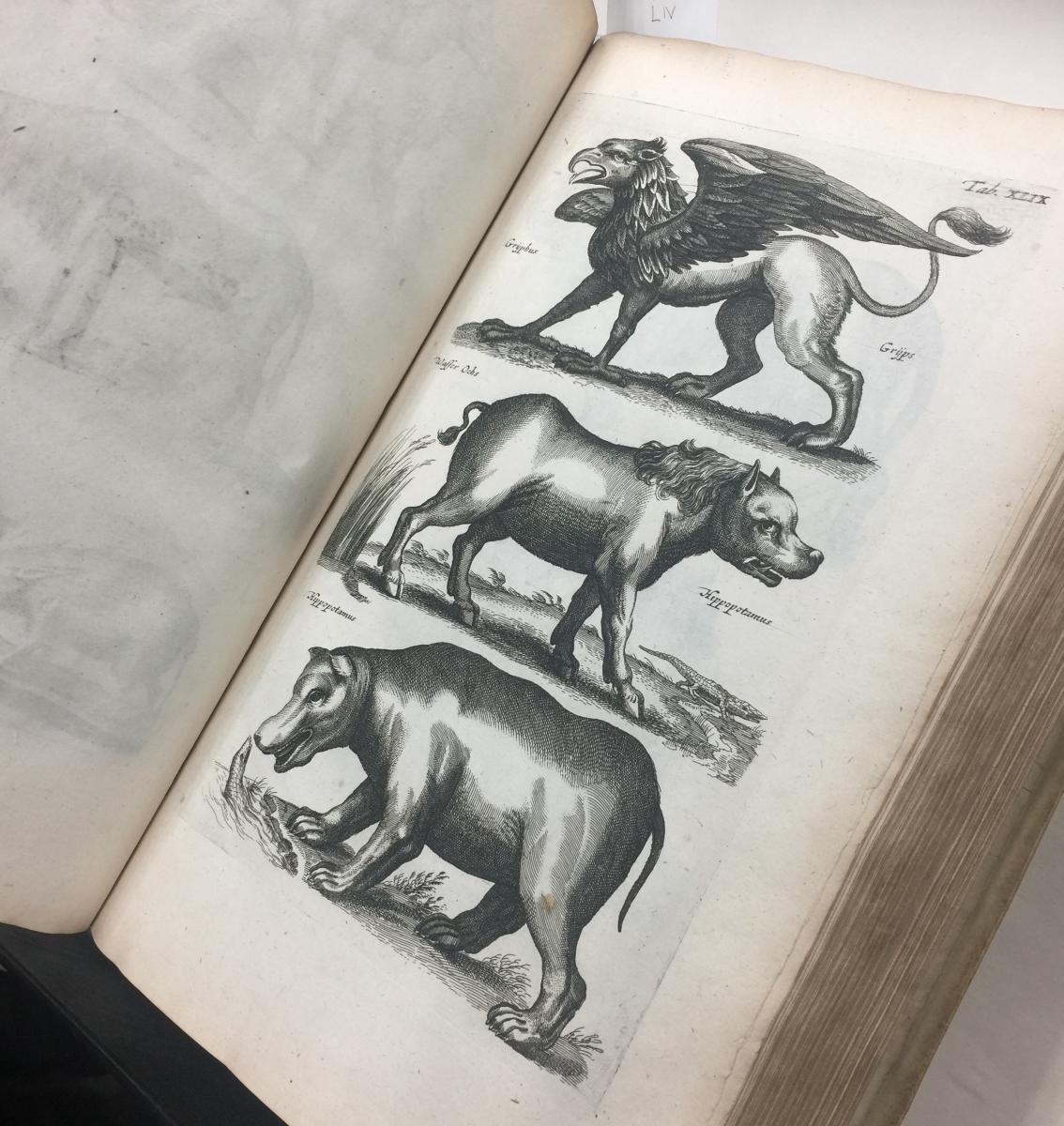
Workshops and Conferences
Albertine Hamilton and Marika Kocsis will be presenting on the conservation treatment of Meek’s Atlas for the ANZMaps Symposium, taking place from 22-23 May 2017 in Melbourne. This will coincide with a tour of the Library’s Conservation and Preservation labs for registered conference attendees, interested in the care and storage of maps, books and atlases.
Preservation Technicians – Savina Hopkins, Leah Williams and Emily Keppel – attended a Pest Control Workshop in March and April, facilitated by Alex Roach, which concentrated on control measures for material entering institutions and eradication techniques.
Social
Conservation welcomes new volunteer Josh Cassidy this month. Josh is in his first year of the Conservation Masters at the University of Melbourne and will be volunteering with the paper conservation team for three months. Meanwhile, paper conservation volunteer Emily Keppel has moved across to the book conservation team.
National Gallery of Victoria
Treatment Projects
The Paper Conservation studio has spent the last few months working on 19th century Japanese woodblock prints in preparation for Van Gogh and the Seasons and Hokusai. Van Gogh was an avid collector of Japanese prints and was greatly influenced by their aesthetic. In reference to this, the exhibition features an entire room of Japanese prints drawn from the NGV’s collection. The Hokusai exhibition which opens in July at NGV International will include prints, paintings and books borrowed from The Japan Ukiyo-e Museum. These works will be supplemented by a selection of works from the NGV’s holdings. Treatment undertaken in preparation for both exhibitions has included, humidification and flattening, infilling of losses and on rare occasions, blotter washing.
The Objects lab have been busy in between collection changeover and acquisition treatments, investigating potential Conservation applications for our newly acquired 3D scanner and printer. Di Whittle has been leading recent efforts to produce printable prototypes for display part replication, equipment mounting components and custom 3D storage packing profiles, as well as the (obligatory) production of a growing range of sculptural collection miniatures. We expect many more scans and applications to come. Trude Ellingsen has been supervising the installation of the magnificent Ai Weiwei chandelier in Federation Court, as well as preparing for the exhibition Every Brilliant Eye: Australian Art of the 1990s. This includes major treatment work carried out on I.O.U. by Mikala Dwyer. The artwork contains a functional 4.5”CRT TV that can no longer be repaired. After consultation with the artist, a mini computer (Raspberry Pi) with a small screen and speaker was used, and fitted in to the original housing. Other components were 3D printed in order to fit into the new set up. Bronwyn Tulloh has been preparing objects for Buddha’s Smile, an exhibition with a wide range of object eras and material types. Marika Strohschneider has worked on rationalising the appearance of a Roman period Aphrodite for the exhibition Love: Art of Emotion 1400-1800, an object with a history of interventions of differing quality.
The paintings conservation studio has seen a succession of treatments for important paintings from the NGV collection, along with some exciting research projects. John Payne has commenced work on one of the Gallery’s great masterpieces, Two Old Men Disputing by Rembrandt. He has removed the old varnish and retouchings and is about to commence inpainting the work, which is mostly in very good condition. Raye Collins has been tackling the not-so-straightforward job of removing a discoloured varnish from another great NGV masterpiece, Amedeo Modigliani’s Portrait of the painter Manuel Humbert. Raye has also carried out consolidation and surface cleaning of Wyndham Lewis’s painting Inferno. Carl Villis is in the middle of a major cleaning and restoration of Rubens’ portrait of King Louis XIII of France. As for the research projects, we hope to reveal one of these in the coming months. Watch this space!
Holly McGowan-Jackson is now in the descent phase of a ‘Mt Everest’ of a treatment, removing overpaint from of an Armchair manufactured by Gebrüder Thonet (c.1930), which has extended over many months. The bentwood chair with an original bright orange nitrocellulose finish was overpainted with brown house paint by the previous owners in the 1970s. From the front, the chair now looks mostly orange, but there is still solvent gel and mechanical work to remove the remaining paint remnants, to be followed by inpainting of losses and worn areas to the surface finish. Holly is looking forward to celebrating when the treatment is completed. Over the last few months Suzi Shaw has been juggling the conservation treatment of numerous frames, furniture and Asian lacquer artworks, for exhibitions and collection changeovers, as well as advising on and condition reporting new acquisitions.
Exhibitions and Loans
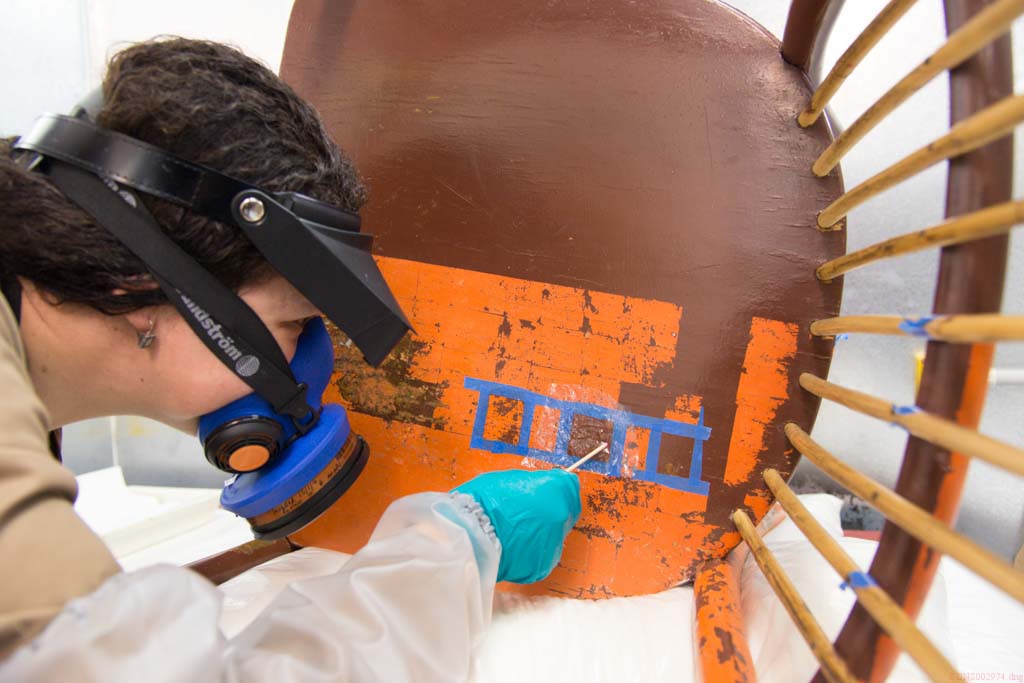
Kate Douglas has been busy managing the delivery of textiles for NGV Permanent Collection changeover program and more than 10 textile artworks, including Leigh Bowery’s 1992 work, Pregnant Tutu Head, and Conversation 1995 by Rosslynd Piggott for Every Brilliant Eye: Australian Art of the 1990s. The textiles team continue to be busy with preparation for The House of Dior: Seventy Years of Haute Couture. Kate McLaren has conserved a partially deconstructed Christian Dior Monte Carlo gown from 1956, and Kate Douglas has spent considerable time perfecting the multiple layers of tulle petticoats and silk roses on Porcelaine, 1958, a Dior gown by Yves Saint Laurent. Staff at the MET Costume Institute have kindly shared details of the original patent leather belt accompanying the Aladin 1947 gown in their collection with Bronwyn Cosgrove, enabling the NGV to produce an historically accurate reproduction belt for our recently acquired Aladin. Ellen Doyle, Textile Display Specialist has been very busy making underpinnings and petticoats for NGV Dior works and recently acquired 18th and 19th century garments for photography and display programs.
Artlab Australia
Presentations
Artist (& Artlab Paper Conservator) Anna Austin recently gave an Artists Talk for the SA/NT AICCM division. Anna spoke about her current exhibition “Annual” at Hill Smith Gallery in Adelaide, and how this body of work led her to a papermaking workshop at the Awagami Factory in Japan where she learnt traditional methods of papermaking, including the preparation of Kozo bark for cooking, cleaning, beating the fibres, papermaking & drying. The audience had an opportunity to handle some of the beautiful papers made during this workshop as well as view close-up some of Anna’s exquisite linocut prints that incorporate techniques of chine colle.

Treatment projects
Objects & Projects labs
Filipa Quintela has treated the magnificent Paul Storr 1820’s silver gilt Dessert Stand for the Art Gallery of South Australia (AGSA). She has completed the treatment of a large mirror backed and framed Seppelt Wines sign.
Jo Dawe has been working on a couple of privately owned items, including a Japanese Satsuma ware vase produced by the Kinkōzan workshop, most likely dating from the Meiji period 1868-1912. The vase required repairs to some old breaks and losses, including some gilding work. She also worked on a marble birdbath, featuring five carved doves sitting on the rim. The birdbath required cleaning, stain removal and stabilisation of the bird attachment points. The marble was waxed to help protect it and prevent future staining.
Megan Sypek has been packing various pieces of furniture by Adelaide maker Khai Liew for storage. The use of light weight crates improves the storage conditions of these items significantly. Megan’s recent work for private clients include a stimulating mix; a bark painting, a low fired ceramic Chinese figure, and a miniature Indian painting on camel bone.
Justin Gare and Sophie Parker undertook a condition check of the Vickers Vimy aeroplane at the Adelaide airport for its biannual inspection. Justin has continued removing bronze paint from a Rayner Hoff plaster maquette for the AGSA.
Before commencing maternity leave, Abby Maxwell-Bowen was busy working on sculpture treatments for the AGSA, and condition assessments and minor treatments for public artworks on display in Adelaide city.
Ian Miles has been working on several outdoor cultural items including a large bronze and copper alloy Roll of Honour at Islington railway, stone repairs to the 25 ‘dry stone’ beehive like structures that flank Sir Donald Bradman Drive titled Lie of the Land by artists Aleks Danko and Jude Walton, and the repair and installation of an aluminium sculpture to the large fountain titled Three Rivers in Victoria Square by artist John Dowie.
Paintings Lab
For the past few weeks the Paintings Team including Eugene Taddeo, Marek Pacyna, Chris Payne, Rita Constable and Rosie Heysen have been working at the National Railway Museum in Port Adelaide treating the exterior of the Murray Car. Commissioned by the South Australian Government in 1933 as a new inspection car for the Railways Commissioner the Murray Car was the last timber bodied railway car built at the Islington Works. When introduced in 1934 it was claimed to be the most up to date car of its kind sporting a Tasmanian Blackwood frame work and sliced Queensland Walnut internal panels. The Murray Car was also used by a number of members of the royal family when visiting Australia, and in its later life for inspection trips between Peterborough, Port Pirie and Broken Hill. Retained by the South Australian State Transport Authority when the South Australian Railways were sold to the Commonwealth Government the Murray Car went in to storage from 1987 in a number of locations including the Adelaide Rail Yards, Islington, Port Augusta and finally entering the National Railway Museum in 1997.
Lisette Burgess has been holding down the fort at Artlab taking History week tours of the Painting Studio giving members of the public a better idea of what we do as conservators.
Textiles Lab
Plenty of storage preparation has been happening in the Textiles lab for recent acquisitions by AGSA including a beautiful Valentino dress worn by artist Del Kathryn Barton on the occasion of her wedding and the three accompanying bridesmaid dresses. Made by Romance was Born the heavily sequined & appliqued dresses were designed in collaboration with each of the pre-teen girls who wore them – explaining why sequined depictions of My Little Pony, butterflies, rainbows and French bulldogs feature so strongly in the designs!
Exhibitions & Loans
Renita Ryan has prepared five Antony Gormley sculptures for display in the Versus Rodin exhibition at the Art Gallery of South Australia. She and Megan Sypek have seen off a loan of Yvonne Koolmatrie basketry to the NGA. Renita and Justin Gare prepared six claymation figures for Bush Mechanics, a National Motor Museum exhibition which will tour nationally. Renita led the Objects team who all worked on the Opals exhibition from the South Australian Museum which is travelling to Doha.
The History Trust of South Australia in collaboration with the State Library of SA will be opening the Centre of Democracy in late May. In preparation for this, several iconic items have been spotted throughout Artlab. The Textiles Lab have been revelling in a 70’s & 80’s time-warp with former South Australian Premier Don Dunstan’s infamous pink shorts (yes, they are very pink and very short!) as well as a replica of Bob Hawke’s Australia Jacket worn on the occasion of the Australia II victory in the America’s Cup.
Adding to the list of iconic items in the lab, Kristin Phillips has been preparing a remnant from the first Aboriginal Flag for display at the South Australian Museum. This remnant is the central ‘dot’ of red & black that was removed when the yellow circle was inserted in the centre of the flag.
Workshops and Conferences
As part of the South Australian Museum Roadshow program, Justin Gare & Kristin Phillips took Lord Carnarvon & Lady Evelyn to Kangaroo Island to educate (and entertain) 450 school children.
Sophie Parker presented the object display component at the ANMM Submerged shipwrecked workshop in Mannum. She also hosted a tour of Artlab for Central Australian artists associated with Desart. The group came to discuss conservation practices and were particularly interested in information provided by Paintings conservators.
Director, Andrew Durham has just returned from presenting a workshop on Collections Care in Museums and Galleries in Penang. Dr Ang Ming Chee, General Manager of George Town World Heritage Incorporated along with the State Museum Board of Penang organised this workshop at the Art Gallery, Dewan Sri Pinang, George Town, Penang. Andrew presented to 30 participants from various Penang state government agencies discussing the principles and theory of collections care; objects examination and condition reporting. To reinforce what they had been learning, each participant prepared their own condition assessments, choosing an object from twenty items that had been selected from the State Museum’s collections.
Social
There are double congratulations for Projects Conservator Abby Maxwell-Bowen on the birth of twin boys Lucas and Morgan, born on May 9 2017.
Stuart Fuller is now working half time in Projects/Objects and Preventive since Abby has commenced maternity leave.
Museum of Applied Arts and Sciences
New Museum update
The Minister for the Arts Don Harwin recently announced that a final business case to be released later this year will expand options for the new Parramatta museum. This could include keeping a Powerhouse presence at the current site in Ultimo. The new museum in Parramatta is to be the flagship campus for the Museum of Applied Arts and Sciences, which also has sites at Castle Hill and Millers Point. The government wants to ensure a new world-class museum is designed with input from the people of Western Sydney.
The NSW government will open up a forum for consultation regarding the Museum of Applied Arts and Science flagship campus in Western Sydney. Expressions of interested are sought.
If you would like the opportunity to participate please follow this link to register: https://mgnsw.org.au/sector/news/new-museum-western-sydney/
Exhibitions and loans
Egyptian Mummies-Exploring ancient lives from the British Museum; Collette Dinnigan and the Shape exhibitions have closed.
The Wiggles exhibition has been revamped and Experimentations renovation complete.
Love is… Australian Wedding Fashion, Microgravity and the annual Student Fashion Exhibition have opened.
We are currently working on a wide range of local, interstate and international loans, including one to MoMA in New York. They have requested a number of our Speedo Olympic swimsuits for display in their upcoming exhibition Is Fashion Modern? We are currently in negotiations regarding how these late 1960s and early 1970s stretch garments can be displayed.
Events and Presentations
The 2017 Steamfest program was delivered at Maitland to enthusiastic crowds and included six ‘Full Steam Ahead!” science shows for children and four 3D printing demonstrations for families, all entertainingly and engagingly delivered by staff members. Approximately 55000 people visited Maitland over the 8-9 April. MAAS Volunteers were once again invaluable in demonstrating the Steam Revolution Discovery Station. A big thank you to John A’Beckett, Ernie Mollenhauer, Garry Horvai, Ken Bruce and Lindie Gaze.

The Museum’s1920s Steam Tip Wagon was a highlight addition this year. As Maitland staff stated “it was great to have it roving around the site, and the crowds certainly appreciated the chance to get up close and ask questions”. Steam engine staff Ralph Boesel and Chris Eagle were key to making sure it was looked after and provided background information and demonstrations. Over the weekend MAAS staff and volunteers personally engaged with 1274 Steamfest visitors.
Research Projects
As a participant in the ARC linkage grant: A national framework for managing malignant plastics in museum collections, Sue Gatenby has commenced the collection survey, initially setting up the plastic Reference library which is based on the RESIN kit. The survey will involve condition assessment and plastic analysis using a Bruker FTIR Alpha –P analyser. This analysis will assist in determining types of deterioration of the plastics. The collection to be assessed is the Plastic Button collection. The results of these collection surveys will contribute to the research carried out by the University Research partners and University of Melbourne thesis students.
A collaborative project with ANSTO investigating an ancient Bronze Chinese wine vessel Jue has been completed. The analysis has confirmed that the vessel is an authentic wine vessel from the Shang Dynasty, 1600-1046 BCE. The analysis also confirmed the method of manufacturing as lost-wax casting.
Sue is also trialling an Olympus XRF detector as a replacement instrument for the deceased Bruker Tracer.
Repackaging and relocation projects
Kate Chidlow and Bronwyn Dunn and a group of dedicated volunteers continue working on the MDC (Museum Discovery Centre) Project. This involves documenting, condition reporting, photographing and re-rolling our flat textile collection of 1600 pieces. They are unearthing some wonderful textiles and by digitising them, we are making them much more accessible.
The end of April saw the successful completion of a 5-month relocation project (I-Store) of over 10,000 objects from the Museums Ultimo site to a new purpose built store at Castle Hill. Conservators Vanessa Pitt, Rebecca Ellis and Carey Ward worked alongside registration and photography to update documentation and prepare and relocate objects.
The new storage facility was designed to help relieve overcrowding within the existing stores and provide for future expansion of the collection. In addition the new store also includes cold storage rooms, which will be used to house plastics and other vulnerable materials in the collection.
Publications
Kate Chidlow completed a draft of a new publication about caring for farm machinery, an extension of Graham Clegg’s Safe in the Shed. It is currently being edited and we hope it will be published and available by July, 2017. We are also reprinting a revised version of the disaster recovery book, ‘All is not Lost’ as it has sold out. We hope this will also be available in July.
Kate is also organising a ‘Train the Disaster Trainer’ workshop at the MDC. This will be conducted by Kay Soderlund of Preservation Australia for the DISNSW members. The rationale is for the DISNSW members to learn and improve disaster training methods for their staff at their own cultural institutions.
Jonathan and Sue are collaborating with Hibbs and Co on a Radioactive object training session and guidelines.
Social
Thanks for your support in the latest International Museum Dance Off 2017. You will see members of the conservation team brandishing their feather dusters in the lab as well as showing off the new storage facilities at Castle Hill. MAAS won the Australia and New Zealand division and in the finals came third but won the Judges Choice award. If you would like to take a look- https://youtu.be/cra0MUi6Www
Vanessa Pitt has been seconded to the Conservation Unit at the Australian Museum for a period of 4 months. Carey Ward is on leave for 6 months recuperating from surgery
Australian Museum
Acquisitions
The Museum is currently in the process of acquiring a Nivanese Ta reo Vanuatu Canoe. The canoe is coming from Newcastle where it was used in climate protests against coal ships. Colin MacGregor and collection staff are looking at the logistics of fumigating and housing this large White wood canoe and Outrigger which is over 6m in length and weighs approximately 400 Kgs!
Treatments Projects
The entire lab is focused on working through countless objects and specimens for the Museums revamped Long Gallery.
Heather Bleechmore has been working on cultural objects from the Aboriginal and Torres Strait Islands collection, including devising a innovative fill for damaged feathers on a Torres Strait Islands headdress. See technical note included in this issue). Currently Heather is in the process of collecting samples from an Egyptian funerary boat for testing, including radiocarbon dating and wood identification.
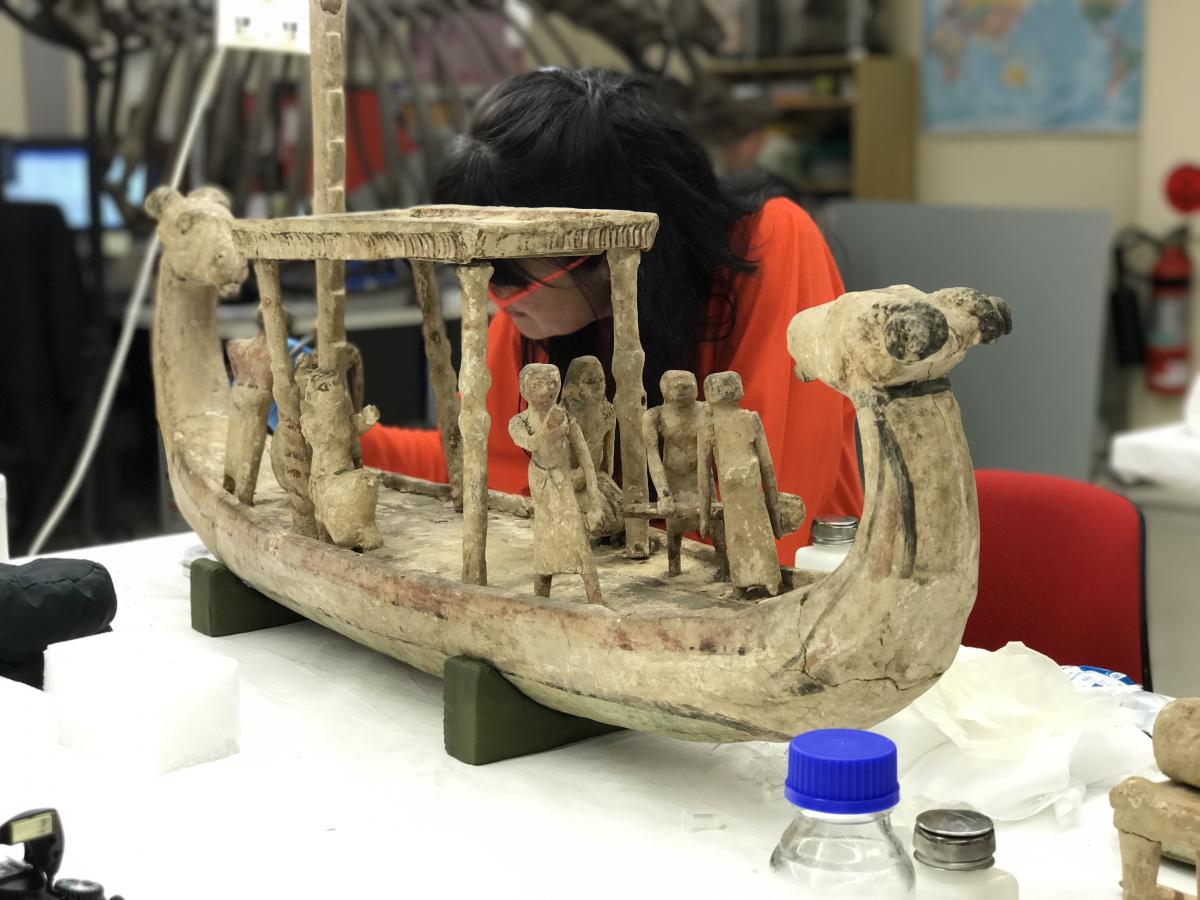
Megan Dean-Jones, as our resident historic taxidermy fish expert, has been up to her gills carrying out transformative treatments on several very old fish specimens, one holding the title of “the second oldest fish in the Collection”.
Brooke Randall has powered through some amazing cultural objects including a shell trumpet collected by Captain Cook on his second pacific vogue, a cuirass and helmet from Kirribati and a ‘Dema’ costume from the Marind-Anim community of West Papa. Brooke will now lend a hand to Sheldon and Megan working through some Natural Science specimens. Brooke currently has her hands full with a large Platypus skin rug.

Sheldon Teare has the rather large task of seeing to a sub-fossilized Irish Elk specimen. This semi articulated beast is in a less than ideal condition and requires some major repairs. The Condition report alone has Sheldon muttering while trying to dredge up skeletal anatomy terminology.
Michael Kelly has been working on a selection of objects and specimens from across the collections to be displayed in the Krefft case. Krefft, an early Director of the museum 1864 – 74 championed the radical new theory of evolution as described by Charles Darwin.
Rebecca Barnott continues to juggle the last of her university commitments, mainly her thesis, and working in the lab three days a week. Rebecca has had a range of objects and specimens sent her way and continues to be a treasured asset in the Lab!
Vanessa Pitt is really relishing the chance to work with the Conservation team at Australian Museum, indulging in her special interest in Natural Science conservation. She is currently working on a Blyth’s Hornbill articulated skeleton from 1781.
Colin has been working with staff from MAAS on the revitalization of the large nitrogen chamber at Castle Hill. The plan is to create more flexible control parameters, install better humidity control and replace the large gas bottle packs with a nitrogen generator.
Social
Vanessa Pitt from the Museum of Applied Arts and Science (Powerhouse Museum) has temporarily joined the team at the Australian Museum. Vanessa has jumped into the deep end to help us out with preparing hundreds of objects and specimens for the upcoming Long Gallery redevelopment. Vanessa will be working closely with Sheldon Teare on a wide variety of Natural Science specimens.
Northern Territory
Museum and Art Gallery at the Museum and Art Gallery of the Northern Territory
New Staff Member
MAGNT are pleased to welcome Eliana Urrutia-Bernard to the conservation fold. Eliana started with us in April as Assistant Conservator as part of the Ian Potter Funded Data Ready Project. We received 57 applications for this position.
 Exhibitions and Loans
Exhibitions and Loans
The Aboriginal Gallery, originally curated by Margie West had not been refurbished since 2005. The gallery was de-installed in April 2017 to make way for the Tjungunutja Exhibition. Community engagement continues as the Curatorial Team and Conservation prepare for the opening event. The exhibition will showcase early Papunya paintings dated from the 1971-1972 period that were acquired by MAGNT’s first Director Colin Jack-Hinton. The publication involves new curatorial research with articles written by leading researchers including Lisa Nolan, Paintings Conservator who was involved with the backing removal process.
Hot! Highlights from the MAGNT Art Collection will be on display until the 13th August including John Brack’s The Fight 1959, oil on canvas which was recently lined. Carolyn McLennan worked on a selection of objects from the MAGNT’s Papua New Guinea collection to supplement a photographic exhibition by photo-journalist Stephen Dupont titled Piksa Niugini.
Loans were also prepared for The Sculptures of Atauro Island exhibition at Charles Darwin University. Sculptures of ancestor figures from Atauro Island, approximately 30 kilometres north of Dili, Timor-Leste are being exhibited.
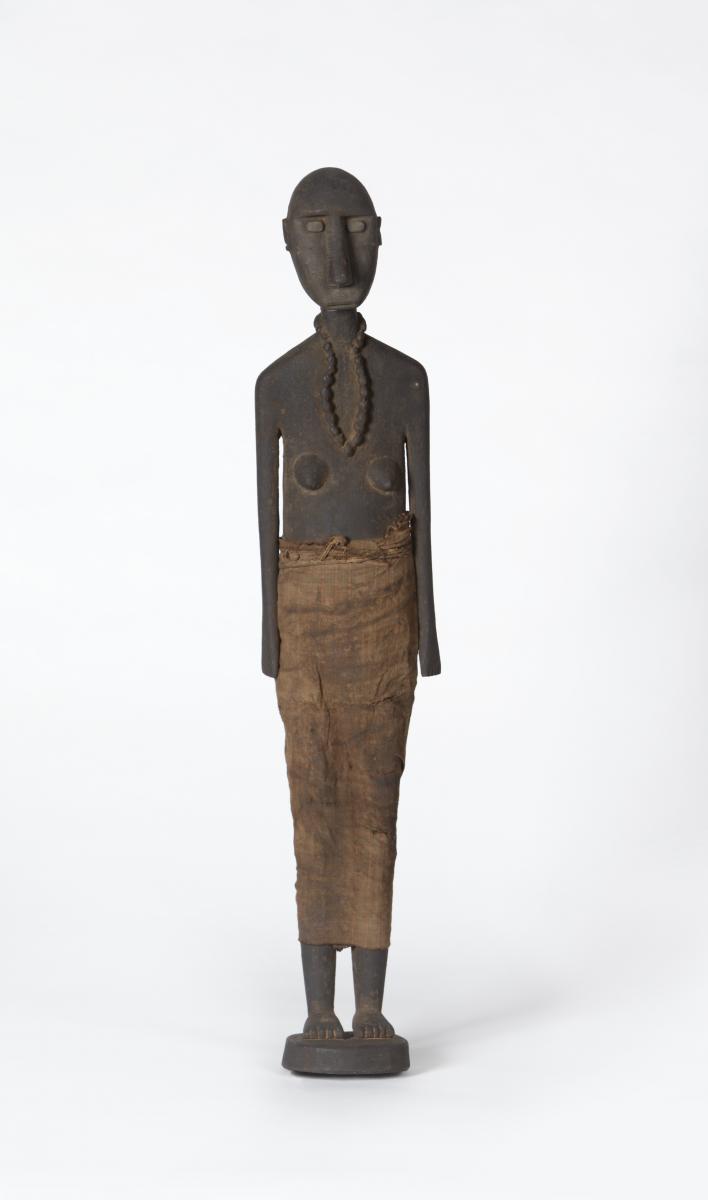 Conference Attendance
Conference Attendance
Sandra Yee attended the book and paper symposium Light|Colour|Structure held at the National Gallery of Australia in October 2016 and was fortunate to be able to attend two workshops – one on local repairs on iron gall ink presented by Eliza Jacobi of the Netherlands, and the other on paper fibre identification hosted by the University of Canberra. Lisa Nolan attended the ‘Revivify’ paintings symposium held at the National Portrait Gallery in Canberra in October 2016 and presented a paper titled ‘Bark Painting Mounts: A journey into the mounting methods at the Museum and Art Gallery of the Northern Territory.’
Carolyn McLennan, Independent Conservator, Darwin
Malfunctioning air conditioning units and the heavy wet season resulted in lots of attention to mouldy paintings, works on paper, fibre artworks and sculptures. A quick dash to Bula’bula Arts, Ramingining was required to deal with some mould effected large fibre mats caused from a problematic air conditioning system. In a one week workshop on preventive measures and treatment for mould the Artists, Art Workers and I worked on the mouldy mats achieving a good result. As I revisit remote area art centres across the Top End I see that it takes years and years to recover from the effects of a natural disaster – Ramingining had cyclones two years ago.

At Jilamara Arts, Milikapiti we’ve just finished the successful Muluwurri Museum Mentoring Project. Over a period of nine months I’d fly from Darwin to Milikapiti every month and work with the Jilamara Executive and five Jilamara Art Workers at the keeping place the Muluwurri Museum. We are now taking steps for the future.